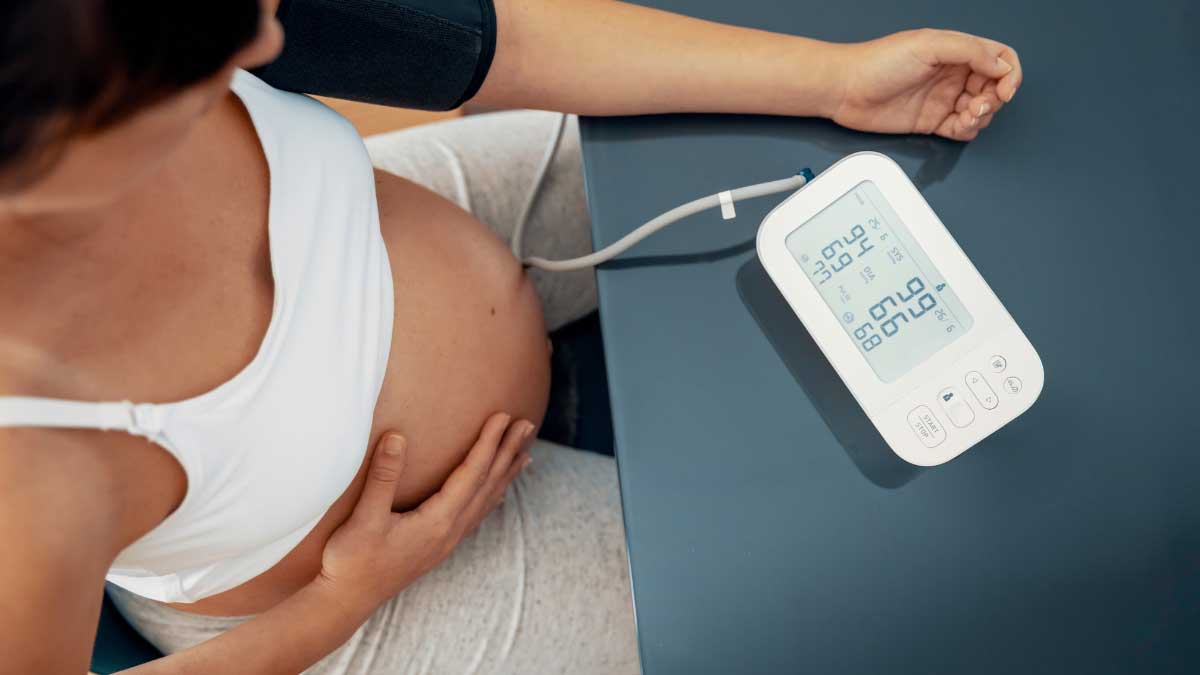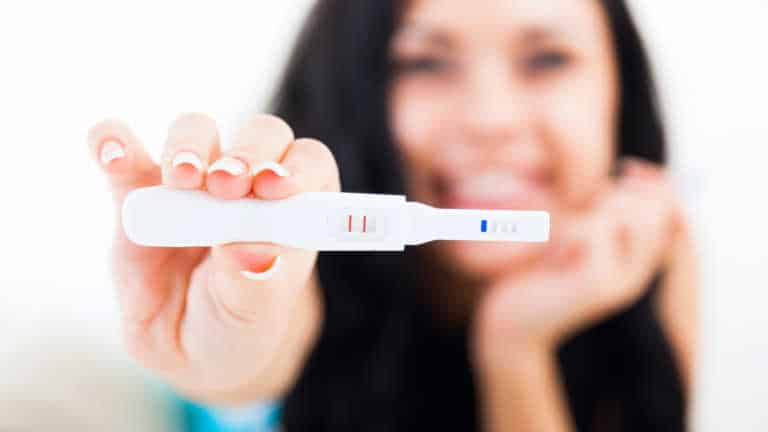Pregnancy is a whirlwind of wonderful changes, but it can also bring surprises. While quirks are part of the journey, it’s important to be aware of preeclampsia symptoms – signs of a pregnancy complication that can mimic some common discomforts.
Preeclampsia is a pregnancy-induced imbalance in your body. While it sounds serious (and it can be), the good news is that it can be effectively managed with knowledge and early detection. This guide will help you decode the signs and symptoms of preeclampsia, empowering you to have a healthy pregnancy.
Symptoms of Preeclampsia
High Blood Pressure
One of the main signs of preeclampsia is high blood pressure. Regular prenatal visits are crucial because they allow your doctor to monitor your blood pressure throughout your pregnancy. A normal blood pressure reading during pregnancy generally falls below 120/80 mmHg. However, with preeclampsia, your blood pressure might consistently rise above 140/90 mmHg.
Protein in Urine
A small amount of protein is usually found in the urine during pregnancy. However, preeclampsia can cause a significant increase in protein levels. A urine test can detect this. While the exact measurement for diagnosis can vary slightly depending on the lab, a reading of 300 mg or higher in 24 hours is often considered a sign of preeclampsia.
Swelling (Edema)
Swollen ankles and feet are a common pregnancy complaint. But with preeclampsia, the swelling might be more excessive and appear suddenly. It can also affect areas that don’t typically swell during pregnancy, like your hands and face.
Other Symptoms
Preeclampsia can manifest in various ways, so be mindful of these additional symptoms.
- Vision Changes: Blurry vision, flashing lights, or seeing spots can be signs of preeclampsia.
- Headaches: Severe headaches that won’t go away, especially if accompanied by light sensitivity, might be a red flag.
- Nausea and Vomiting: While nausea and vomiting are common in early pregnancy, a sudden recurrence in the second half can be concerning.
- Upper Right Abdominal Pain: Persistent pain in the upper right abdomen can indicate preeclampsia.
- Shortness of Breath: Difficulty catching your breath, especially when lying down, might be a symptom.
- Sudden Weight Gain: Gaining more than 2 pounds in a week can be a sign of preeclampsia, especially if it’s due to fluid retention, not increased food intake.
- Decreased Urine Output: If you’re urinating less frequently than usual, mention it to your doctor.
- Changes in Reflexes: Altered reflexes can be a symptom of preeclampsia.
- Dizziness or Lightheadedness: Feeling faint or dizzy upon standing can be a sign.
- Excessive Fatigue: Unusual and persistent fatigue can be a red flag.
Progression of Symptoms
The timing and progression of preeclampsia symptoms can vary. They often develop sometime after the 20th week of pregnancy, but some women experience them earlier or even after delivery (postpartum preeclampsia). It’s important to be aware of these symptoms throughout your pregnancy.
Don’t Wait: The Importance of Early Detection
While some preeclampsia symptoms might seem like typical pregnancy discomforts, early detection is crucial. Knowledge is power! Recognizing these signs and getting prompt medical attention can make all the difference for you and your baby. Here’s why early detection matters.
Protecting Your Health
Untreated preeclampsia can lead to serious complications for both you and your baby. In mothers, it can cause damage to vital organs like the liver, kidneys, and brain. In severe cases, it can even lead to seizures (eclampsia).
Safeguarding Your Little One
Preeclampsia can restrict blood flow to the placenta, potentially affecting your baby’s growth and development. It can also increase the risk of premature birth, which can come with its own set of health challenges for newborns.
Long-Term Impact
Research suggests that having preeclampsia might increase your risk of developing certain health conditions later in life, such as high blood pressure and heart disease. Early diagnosis and management can help mitigate these long-term risks.
The bottom line? If you experience any of the symptoms mentioned earlier, don’t wait! Call your doctor or healthcare provider right away. They can assess your situation, run the necessary tests, and develop a personalized plan to keep you and your baby healthy.
When to Call the Doctor
Listen to your intuition! While the occasional headache or swollen ankle might be nothing to worry about, it’s always better to err on the side of caution. If you’re researching preeclampsia symptoms, your gut is telling you something might need professional attention. Here’s the golden rule:
Call your doctor or healthcare provider immediately if you experience any of the above preeclampsia symptoms.
Remember, early detection is key! By being proactive and reaching out to your doctor, you can ensure a healthy pregnancy journey for both you and your little miracle.
Diagnosis and Treatment of Preeclampsia
Now that you’re armed with knowledge about preeclampsia symptoms, let’s talk diagnosis and treatment.
Diagnosis
If you experience any concerning symptoms, your doctor will likely perform a series of tests to diagnose preeclampsia. These might include:
- Blood pressure checks: Regular monitoring will be crucial to track your blood pressure levels.
- Urine tests: A simple urine test can detect the presence and amount of protein in your urine, a key indicator of preeclampsia.
Depending on your specific situation, your doctor might also recommend additional tests to assess your and your baby’s well-being. However, these are typically done in a clinical setting and not at home.
Treatment Options
The good news is that preeclampsia can be effectively managed with the right approach. Treatment options will vary depending on the severity of your condition and how far along you are in your pregnancy. Here’s a glimpse of what you might expect.
Medication
Certain medications can help control your blood pressure and prevent seizures. Common choices include hydralazine, labetalol, and nifedipine.
Lifestyle Changes
Depending on the severity, your doctor might recommend adjustments to your daily routine, like increased bed rest or dietary modifications.
Hospitalization
In some cases, close monitoring in a hospital setting might be necessary. This allows for continuous monitoring of your health and your baby’s development.
Early Delivery
If preeclampsia is severe and poses a significant risk to you or your baby, early delivery might be the best course of action.
Your doctor will create a personalized treatment plan based on your specific circumstances. Always communicate openly with them and ask any questions you might have.
Risk Factors for Preeclampsia
While preeclampsia can affect any pregnancy, certain factors can increase your risk. Here’s a breakdown of some common ones.
- First Timer: Being pregnant for the first time puts you at a slightly higher risk.
- Age Matters: Both very young (teens) and older (over 40) mothers have a higher risk.
- Chronic Conditions: Underlying health issues like chronic high blood pressure, diabetes, or kidney disease can increase susceptibility.
- Multiples: Carrying multiples (twins, triplets, etc.) is a risk factor.
- Previous Preeclampsia: If you had preeclampsia in a previous pregnancy, you’re more likely to experience it again.
High-Risk Categories
It’s important to note that some factors significantly elevate your risk of preeclampsia. If you fall into any of these categories, be sure to discuss them with your doctor early in your pregnancy.
- Preexisting chronic high blood pressure
- Preexisting kidney disease
- Autoimmune disorders like lupus
- A history of severe preeclampsia in a previous pregnancy
By knowing your risk factors and staying informed, you and your doctor can create a proactive plan to monitor your health and ensure a smooth pregnancy journey.
Reducing Your Risk of Preeclampsia
While there’s no guaranteed way to prevent preeclampsia, certain lifestyle choices can help lower your risk. Here are some positive moves you can make.
Prenatal Care
Regular prenatal visits are crucial for monitoring your health and identifying potential problems early on. Don’t skip those appointments!
Fueling Your Body Right
Maintaining a healthy diet rich in fruits, vegetables, whole grains, and lean protein is essential. It provides the nutrients you and your baby need while keeping your blood pressure in check.
Staying Active
Regular exercise, with your doctor’s approval, can improve blood flow and overall well-being. It doesn’t have to be intense – brisk walks or prenatal yoga can do wonders.
Pre-Pregnancy Prep
If you’ve had preeclampsia during a previous pregnancy and are hoping to avoid it the second go around, you can focus on your health before you even conceive again. Here are some preconception tips to consider.
Manage Existing Conditions
If you have any chronic health conditions like high blood pressure or diabetes, getting them under control before pregnancy can significantly reduce your risk of preeclampsia.
Maintain a Healthy Weight
Being at a healthy weight before pregnancy can also play a role in reducing your risk. Discuss your risk factors with your doctor to optimize your health throughout your pregnancy.
Managing Emotions and Stress with Preeclampsia
Preeclampsia can be a scary diagnosis, and it’s perfectly normal to feel overwhelmed or anxious. But now that you’re armed with information, you can take charge of your health and advocate for yourself and your baby. Here’s the good news: preeclampsia is a treatable condition, especially when detected early. With proper medical care and close monitoring, most women with preeclampsia have healthy pregnancies and deliveries.
Taming the Stress
Pregnancy is a whirlwind of emotions, and preeclampsia can add an extra layer of stress. Here are some tips to help you stay calm and centered.
Lean on Your Support System
Don’t be afraid to confide in your partner, family, friends, or therapist. Talking about your concerns can be incredibly helpful.
Focus on Relaxation Techniques
Deep breathing exercises, meditation, or prenatal yoga can work wonders for managing stress and anxiety.
Prioritize Self-Care
Make time for activities that make you feel good, whether it’s reading a book, taking a warm bath, or listening to calming music.
Stay Positive
Surround yourself with positive affirmations and focus on the happy outcome – a healthy baby in your arms!
FAQ
Can I have preeclampsia without any symptoms?
Yes, it’s possible to have preeclampsia without any visible symptoms. This is why regular prenatal care with blood pressure checks and urine tests is crucial for detecting preeclampsia even without obvious symptoms.
Will I have preeclampsia in every pregnancy?
Not necessarily. Having preeclampsia in one pregnancy increases your risk of having it in future pregnancies, but it doesn’t guarantee it. The severity and even the symptoms can vary between pregnancies.
Can preeclampsia be cured?
Preeclampsia itself isn’t cured, but it typically resolves after delivery of the baby. Treatment focuses on managing the condition and ensuring the health of both mother and baby throughout the pregnancy.
Are there different levels of preeclampsia (such as mild vs. severe)? If so, what are the differences?
Yes, preeclampsia can range from mild to severe. In mild cases, blood pressure might be slightly elevated, and protein levels in the urine might be mildly abnormal. Severe preeclampsia involves higher blood pressure readings, significant protein in the urine, and additional symptoms like severe headaches, vision changes, or upper abdominal pain. Your doctor will assess the severity to determine the best course of treatment.
Are there natural remedies for managing preeclampsia symptoms?
There are currently no proven natural remedies for managing preeclampsia symptoms. If you’re experiencing signs of preeclampsia, it’s crucial to seek medical attention from a qualified healthcare provider for proper diagnosis and treatment.
Can men develop preeclampsia?
No, men cannot develop preeclampsia. It’s a pregnancy-specific condition linked to changes in the placenta and blood vessels.
Resources & Further Reading
Pregnancy is a beautiful journey, but it’s important to be aware of potential complications like preeclampsia. By familiarizing yourself with the signs and symptoms of preeclampsia, you can become an active participant in your healthcare.
The key takeaway? Don’t wait! Early detection is SO important for effectively managing preeclampsia. If you experience any concerning symptoms, call your doctor immediately.
Resources
For more information on preeclampsia, you can visit these reputable sources:
Connecting with Other Moms
If you’re looking for support and connection with other moms navigating preeclampsia, here’s a helpful online forum:
You’re not alone on this journey. With proper prenatal care and medical intervention, most cases of preeclampsia can be successfully managed. You can navigate preeclampsia and have a healthy pregnancy.








